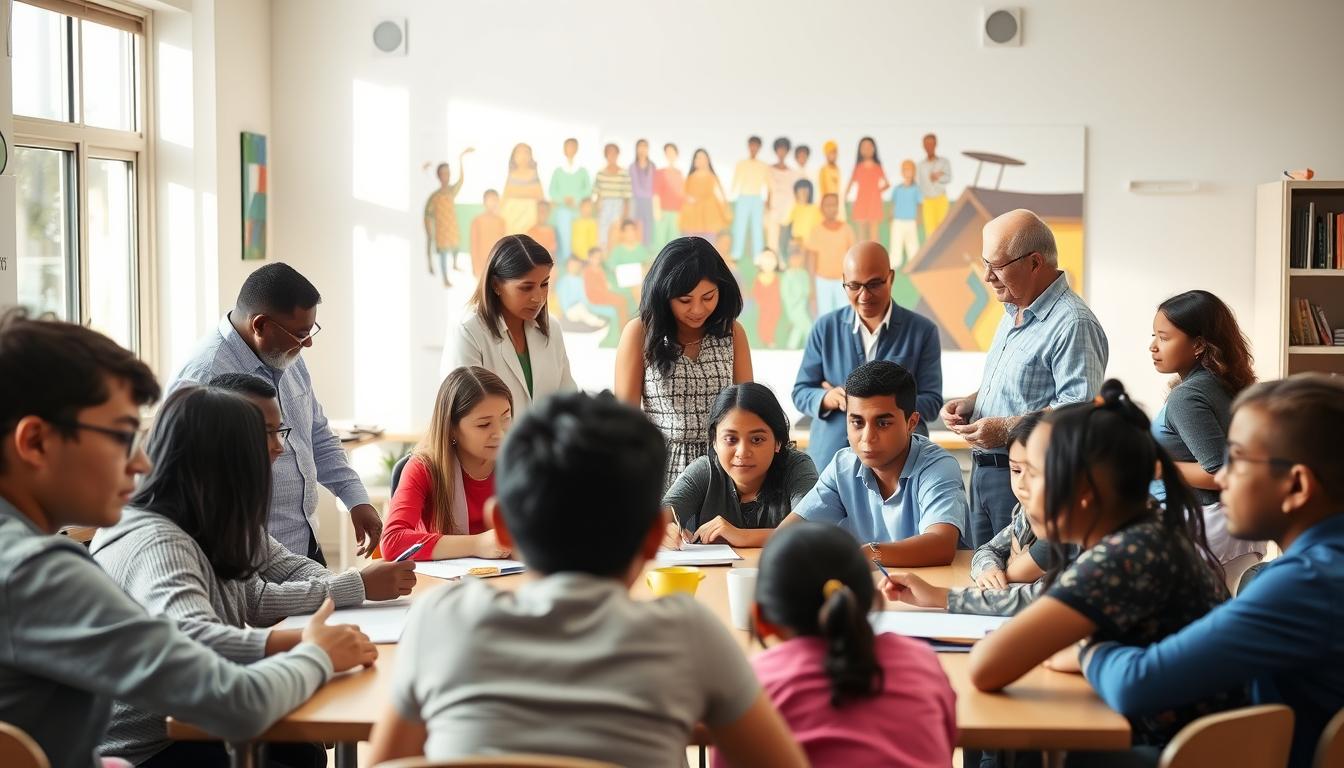Acquiring New Languages: Resources and Benefits for Immigrants
Learning a new language is key for immigrants wanting to succeed in a diverse world. It opens doors to better jobs and helps understand different cultures. In places like the United States, speaking more than one language makes life and work better.
There are many resources for immigrants to learn new languages. These tools help people become fluent faster. This makes communities more welcoming and values bilingualism.
What is Language Acquisition?
Language acquisition is key for those wanting to improve communication skills or understand how we learn. It’s about how we get to know and use language. Mastering language opens up many personal and professional doors.
Definition and Importance
Language acquisition is vital for our minds and social skills. It covers learning our first and second languages. This skill is crucial for building relationships with others.
Natural vs. Formal Acquisition
Natural language learning happens when we’re surrounded by language, like kids learning their first words. Formal learning, on the other hand, happens in classrooms with set teaching methods. Both ways can make us fluent, but they’re different.
Stages of Language Development
Knowing the stages of language learning helps us learn better. It starts with getting to know sounds and words. Then, we grow our vocabulary and learn to make more complex sentences.
Finally, we become fluent, able to communicate well. Recognizing where we are in these stages helps us improve our second language skills.
The Benefits of Learning a New Language
Learning a new language brings many benefits to our daily lives. For immigrants, it’s more than just talking to people. It changes how we think and connect with different cultures. Being able to speak multiple languages helps us move through different worlds with ease and understand their depths.
Enhancing Communication Skills
One big plus of learning a new language is better communication. People feel more confident in sharing their thoughts and getting others. This skill helps in both personal and work life, opening up new chances for friendships and career growth.
Boosting Cognitive Abilities
Learning a new language also boosts our brain power. Studies show it makes us better at solving problems and thinking on our feet. It trains our minds to be more flexible and sharp, helping us handle new situations with ease. Being bilingual also sharpens our memory and multitasking skills, making us smarter and more versatile.
Building Cultural Connections
Learning a new language helps us connect with different cultures. It lets us grasp cultural subtleties and engage more deeply with our communities. This connection enriches our social life, allowing us to appreciate various viewpoints and traditions. It also makes us more open to new experiences and cultural events.
Key Resources for Language Learning
Many immigrants find language learning resources crucial. Tools and platforms make it easier and more fun. Mobile apps, online courses, and community workshops help a lot.
Language Learning Apps
Mobile apps have changed language learning. Duolingo and Babbel offer fun exercises for all learners. They let you practice anywhere, anytime.
Online Courses and Platforms
Coursera and Udemy have lots of online courses. They teach many languages at different levels. You can learn when it’s best for you.
Community Classes and Workshops
Community workshops are great for practicing. They offer a place to talk with others. This boosts your confidence and makes learning more enjoyable.
The Role of Immigrant Communities in Language Learning
Immigrant communities are key in helping people learn new languages. They offer support that lets newcomers grow. Cultural exchange programs help share languages and experiences, benefiting everyone involved.
Cultural Exchange and Support
Cultural exchange makes learning a language more than just words. It lets immigrants join in local events and talk with native speakers. This helps them fit in better and learn more about their new home.
Local Mentorship Programs
Many places have mentorship programs for language learners. They match experienced speakers with those who are new. Mentors help learners practice and understand the language better, sharing tips on everyday talk.
Peer Learning Opportunities
Learning with peers is common in these communities. People form study groups or chat partners. This way, they learn together, practice speaking, and make friends.
Strategies for Effective Language Acquisition
Using effective language learning strategies can really help. By trying different methods and tools, you can get better at speaking and understanding a new language.
Immersive Learning Techniques
Immersive learning is a great way to learn a language. Talking with native speakers makes you sound more natural. Watching movies and listening to music in the target language also helps you understand better.
Consistent Practice and Exposure
Practicing regularly is key to learning a new language. Set aside time each day to speak, write, and listen. Doing this every day makes you more confident and fluent.
Utilizing Multimedia Resources
Using multimedia resources can make learning fun. Podcasts, online games, and videos are great for learning new words and how to pronounce them. They cater to different learning styles, making learning exciting and varied.
Overcoming Challenges in Learning New Languages
Learning a new language can be tough. You might face language barriers and differences in dialect. It’s important to know these challenges to learn well. Using the right techniques can make learning fun and help you communicate better.
Addressing Language Barriers
Starting to talk in a new language can make you nervous. It’s key to find ways to overcome these barriers. Talking a little with native speakers is a great way to practice.
Being curious in conversations can help you feel more at ease. Learning common phrases and listening well can boost your confidence.
Navigating Different Dialects
Understanding different dialects is important in multilingual communities. Seeing language as a living thing helps you learn more. Hearing various dialects makes you better at talking in different places.
Watching media in different dialects is a fun way to learn. It helps you understand the differences and nuances.
Finding Motivation and Consistency
Keeping motivated is crucial in learning a language. Setting goals helps you stay on track. Celebrating small wins keeps you excited.
Doing fun activities like watching movies or reading books in the target language helps. It makes learning a language a fun journey, not a chore.
The Connection Between Language and Identity
Language and identity are closely linked, forming a key part of who we are. It’s not just for talking; it’s how we express ourselves and connect with our roots. Each language has its own special words, sayings, and ways of speaking. This makes the language identity connection strong in communities.
Language as a Tool for Self-Expression
Language lets us share our thoughts, feelings, and stories. It’s a big part of who we are. People who speak many languages can explore different sides of themselves and their cultures.
Preserving Cultural Heritage
Keeping our native languages alive is crucial for cultural heritage. It helps pass down history, traditions, and values to future generations. This way, young people can learn about their heritage through stories, songs, and rituals in their native languages.
The Impact on Community Integration
Language helps bring people together in diverse communities. When we can talk to each other, we feel more connected. Shared languages help us understand and respect each other, creating a welcoming community for all.
Learning in a Multilingual Environment
In today’s world, speaking multiple languages is key. It’s not just about talking to people from different places. It also helps our brains grow and understand different cultures. People who speak many languages have to find ways to manage them well.
Benefits of Multilingualism
Being multilingual has many benefits. It makes us better at solving problems, being creative, and thinking critically. Studies show that those who speak many languages are very good at adapting. They also get to know different cultures better, which helps them connect with others more deeply.
Strategies for Managing Multiple Languages
To handle many languages well, we need to plan. Here are some tips:
- Make a schedule for each language, so you know when to use which one.
- Switch between languages when you talk to practice speaking fluently.
- Join in on community events, language meetups, or cultural festivals to use your languages in real life.
Effects on Cognitive Flexibility
Speaking many languages changes how our brains work. It makes us better at changing tasks and solving new problems. This skill helps us do well in school and at work. Living a multilingual life makes our brains stronger and more flexible.
The Science Behind Language Acquisition
The science of language acquisition shows how our brains learn languages. It looks at the brain’s parts that get active when we learn. This knowledge helps us find better ways to teach and understand language.
Neurological Aspects of Learning Languages
The brain is amazing at changing and rearranging itself. Areas like Broca’s and Wernicke’s are key for language. Studies show these areas light up when we learn new words and grammar.
Critical Period Hypothesis
The critical period hypothesis says there’s a certain time to learn languages best. Kids who start before seven often get better at speaking. As we get older, it gets harder to change our brains for new languages.
The Impact of Age on Learning
How old we are affects how well we learn languages. Young kids pick up new sounds and rules easily. But, older learners might struggle with their own language getting in the way.
Technology’s Influence on Language Learning
In today’s world, technology is key to learning new languages. Many tools have come out, making learning easier. They mix old ways with new ones, making learning fun and interactive.
Language Learning Tools and Gadgets
Many tools and gadgets have changed how we learn languages. Apps like Duolingo, Babbel, and Rosetta Stone offer lessons for everyone. They make learning a game, making it fun.
Also, gadgets like translators help us talk in real life. They let us practice every day.
The Role of Social Media
Social media is great for learning languages. Sites like Facebook, Instagram, and Twitter help us meet native speakers. We can join groups and share tips.
These sites help us talk like a local. We learn new words and phrases. It’s a great way to improve our speaking skills.
Virtual Reality in Language Acquisition
Virtual reality is a new way to learn languages. It lets us practice in real-life situations. We can order food or shop without fear.
It makes learning exciting and memorable. We get to use our skills in fun ways.
Case Studies: Successful Language Learners
Looking into the lives of those who mastered a new language shows amazing stories. These people show how good language programs and new ideas helped them. Their stories highlight the importance of language in connecting with a new culture and achieving goals.
Immigrants Who Overcame Language Barriers
Immigrants often struggle with language barriers, making it hard to fit in. Their stories of overcoming these challenges are inspiring. Many found help through local classes and mentors, creating a supportive learning environment.
Innovative Language Programs That Work
New programs are being created to help language learners. These programs use technology and community help to improve learning. For example, language exchange programs pair learners with native speakers for real conversations. This not only improves language skills but also builds friendships and cultural understanding.
Personal Stories of Cultural Integration
Stories of cultural integration through language show its deep impact. People share how learning a new language helped them find jobs, make friends, and join their communities. These stories show how language learning can lead to feeling at home in a new place.
Future Trends in Language Acquisition
The world of communication is changing fast, and language learning is no exception. New tech like AI and adaptive learning is changing how we learn languages. These tools offer learning experiences that fit each person’s needs and pace.
This makes learning languages more accessible and effective than ever.
Emerging Technologies in Language Learning
New tech like augmented reality and immersive environments is changing education. These tools help learners remember words and grammar better. They also let learners practice in real-world settings.
These advancements show how important tech is in language education. They help learners get feedback and interact with others in real time.
Shifts in Educational Approaches
Education is moving towards more inclusive and personalized methods. Teachers are using strategies that respect learners’ cultural backgrounds. This approach boosts language skills and appreciation for different cultures.
It’s key for thriving in our global society.
The Increasing Importance of Bilingualism
In today’s job market, speaking multiple languages is more valuable than ever. Employers want people who can communicate across cultures. This shows how crucial bilingualism is for success in different settings.
As bilingualism becomes more important, it helps people understand and work together better.
FAQ
What is language acquisition?
What are the advantages of being bilingual?
What is the critical period for language acquisition?
How can immigrants effectively learn a new language?
What role does community support play in language learning?
What are some effective resources for learning a new language?
How does technology impact language acquisition?
What challenges do learners face when acquiring a new language?
Published on: 5 de February de 2025

Luke Martin
Luke Martin, author of Credwallets.com, is a mathematics graduate with a specialization in financial markets. Known for his love of pets and his passion for sharing knowledge, Luke created the site to provide valuable insights into the complexities of the financial world. His approachable style and dedication to helping others make informed financial decisions make his work accessible to all, whether they're new to finance or seasoned investors.







